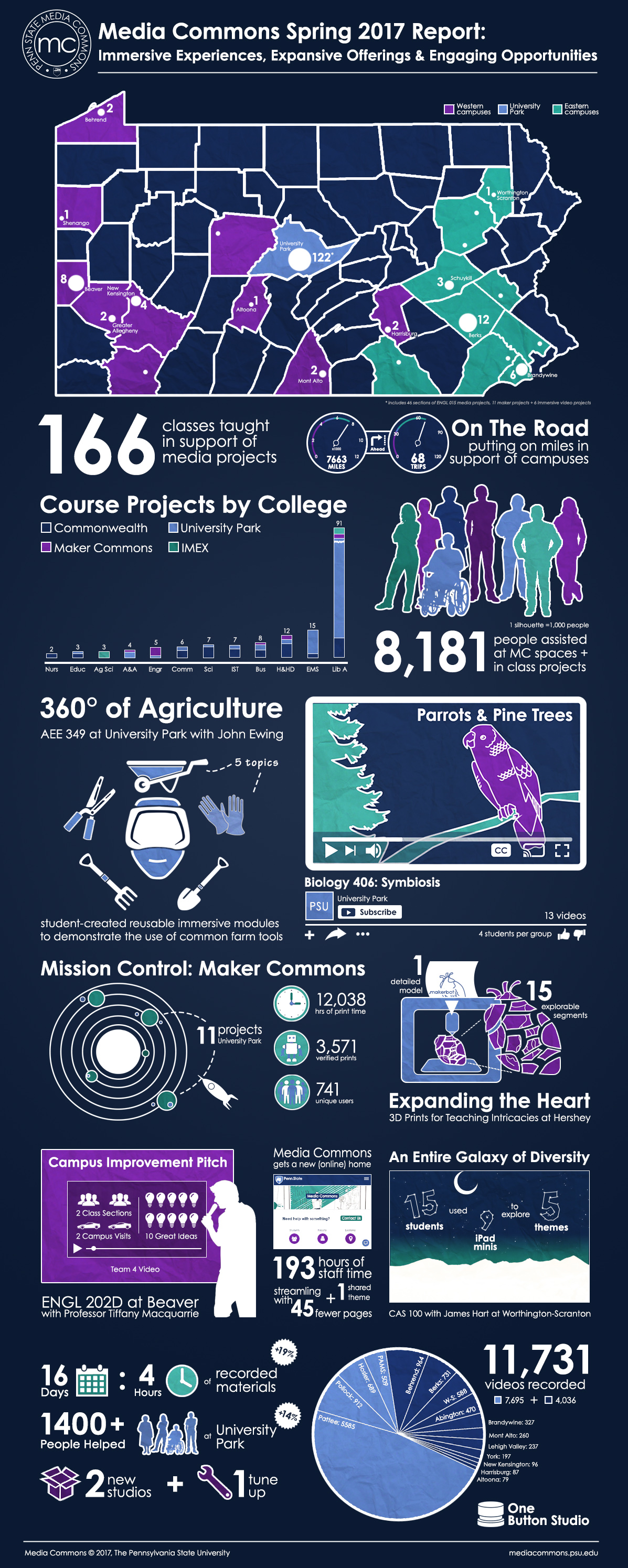
Spring 2017 Report
Spring 2017 saw 8,181 students and faculty use the Media Commons and Maker Commons initiatives across the Commonwealth. Much of this use was focused in 166 classes in nearly every discipline offered at Penn State. To facilitate these interactions outside of University Park, traveling consultants visited campuses 63 times to offer instruction and consultations.
One Button Studios at 14 campuses helped students and faculty create 11,846 academic videos, comprising over 16 straight days of video. During the Spring, University Park staff made 5 campus visits in support of One Button Studio installations. Students across the state also created 3,571 3D prints in pursuit of their own curiosity and course work.
At University Park, the Media Commons in room 109 of the Agricultural Sciences & Industries building was closed for most of the semester. This space is being renovated into our new Immersive Experiences Lab for Fall 2017. Spring semester 2017 was the first semester to offer 360° video workshops and support 360° video assignments, notably in the College of Agricultural Sciences and the College of Liberal Arts. AEE 349, Shop Processes for Agricultural Educators, was the inaugural class to use 360° videos as a student assignment. Students used the new medium to show Ag Education processes and procedures, like welding, laying patio pavers, or safety protocols. The College of Liberal Arts contains our largest partnership, ENGL 15, which accounts for 46 of the classes. ENGL 15 is a required course and provides students with early exposure to Media Commons and TLT resources. Pollock building Media Commons has added a Lightboard to one of its two One Button Studios to create a faculty-focused recording space. Biology 406 students at University Park created videos of an example of symbiosis or critical evaluation of primary literature.
Across the Commonwealth, the One Button Studio continues to make an impact with five trips in support of the resource and Shenango campus installing a One Button Studio most recently at the end of the Spring term. In terms of video, students in ENGL 202D at the Beaver campus created campus improvement pitch videos that were shown in class in support of group presentations. The course, taught by Tiffany MacQuarrie, saw teams researching viable enhancements to campus learning spaces, programming offerings and student life amenities. Video projects synthesized the findings of this research and packaged it together in an engaging way for a broad audience.
Media Commons provided in-class training on our resources, video production and storyboarding and then followed up with in-person storyboard review sessions and remote support for ten groups of learners. Three sections of ENGL 202C at Berks worked with the Media Commons on podcast assignments. The students were challenged with a technical writing assignment in which they would explain how to complete a given task, e.g. changing a flat tire. They took that written assignment, adapted it for an audio project, and used GarageBand to complete a professional grade podcast of step-by-step directions for completing a task.
3D printing in the Maker Commons continues to be refined, now touting a 90% success rate on print requests – up from 70% in Fall 2016. The service now averages 108 prints per printer during the semester using 32.5 grams of filament per print.
The Media Commons received a new and improved website by the end of Spring. Staff spent 193 hours (24 work days/8 full days) of dedicated time moving content, creating new graphics and refining materials. 45 pages of content were either merged with other content or removed in order to streamline the visitor experience, bringing the total to 111 pages. The Community section received a connected services section that explains how Media Commons fits in with Maker Commons, Immersive Experiences Lab and Design Experiences Lab in addition to the larger realm of TLT.
The report that follows breaks down our interactions with students and faculty and examines engagement levels with services offered, locations, and by individual colleges. Throughout the report we’ll draw attention to exciting assignments, surprising class partnerships, and interesting observations from the semester – stories that tell the ways in which Penn State faculty and students are pushing the boundaries of education into the future. We’ll also point out usage and technology trends that draw from Media Commons’ proven history in supporting multimedia and emerging technology as well as reflect on challenges and opportunities in the coming semesters.
